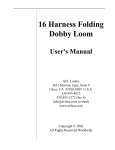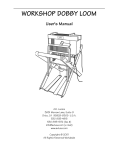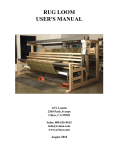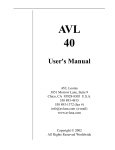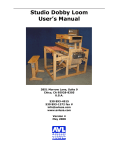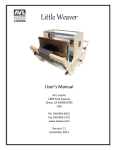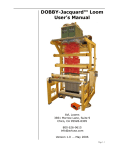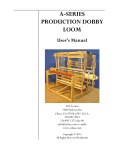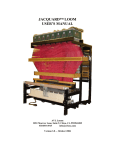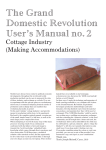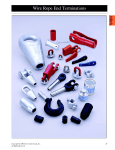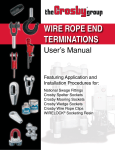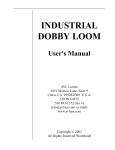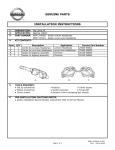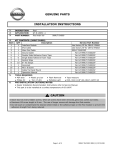Download Rug Loom Cover Page
Transcript
Rug Loom User’s Manual AVL Looms 3851 Morrow Lane, Suite #9 Chico, CA 95928-8305 Customer Service: 888 893-0913 Sales: 800 626-9615 EM: [email protected] TABLE OF CONTENTS Preface 1 Before You Begin 1 Tools 3 • • Necessary Tools Helpful Tools 3 3 • Figure 1 - Hardware Identification Chart 4 Hardware • Hardware Hints 5 5 Assembly Sequence 6 • • Side Frame Assembly Figure 2 - Right Side Frame Assembly 11 12 • • Figure 3 - Left Side Frame Assembly Lower Back 13 14 • Figure 4 - Assembling Lower Left Back Corner 14 • • Spring Lever Assembly Harness Pulley Support Assembly 15 15 • • Square the Frame Lower Front 16 16 • • Upper Back Figure 5 17 17 Page TOC-1 • Level the Frame 18 • Figure 19 34 • • Dobby Assembly Beater Assembly 18 18 • • Figure 20 - Brake Drag Strap Figure 21 - Brake Cable Adjuster 35 35 • • Figure 6 Air System 19 20 • • Figure 22 Apron 36 37 • • Figure 7 - Dobby/Side View Figure 8 20 21 • Connect the Air System • Compressor 37 37 • • Figure 9 - Dobby/Front View Figure 10 - Basic Rug Loom Air System 22 23 • • Set Main Air Pressure System Test 38 38 • • Figure 11 Harnesses Assemblies 24 25 • Add Oil 38 • • Figure 12 Cloth Storage Beam Assembly 27 28 • • Figure 13 - Cloth Storage Beam Figure 14 - Installing Cloth Beam 28 28 • • Cloth Beam Assembly Figure 15 29 30 • • Separation Rollers Figure 16 - Installing Separation Roller 31 31 • • Worm Drive Figure 17 - Cloth Storage Crankshaft 32 • Assembly Warp Beams 32 33 • • Figure 18 - Cloth Beam Handle Brake Cable Assembly 33 34 Page TOC-2 PREFACE BEFORE YOU BEGIN We hope this manual will do three things for you: 1. Guide you, step by step, through the assembly of your loom — so you’ll be immediately satisfied with its function. 2. Help you learn about its various systems and components — so you’ll be an even more capable weaver. 3. Inform you about the care and maintenance of your loom — so you’ll enjoy a lifetime of dependable service. As we've already said, it’s important that you read this manual and follow its instructions from beginning to end. A quick read through before you actually pick up a tool will give you a good overview of the whole assembly process. The Table of Contents will direct you to each of the major sections. You’ll note that at various places in the text, we’ve inserted a [ ]. This is a reward box. Just add a checkmark as you complete each segment of work. You’ll feel great and it’ll help you stay organized. Page 1 We know that sometimes you've just got to have a picture, so we've included graphic support where it seems necessary. You may wish to photocopy some of these illustrations and bring them forward with you as you work through the manual. This will save you a good deal of flipping back-andforth in search of that oh-so-helpful diagram. You'll probably find, for example, that you need to refer constantly to the Hardware Identification Chart (Figure 1) and Loom Illustrations (Figures 2 through 4). One last bit of advice: Even the narrower rug looms will require the efforts of two people for many of the assembly operations. Several of the components can be quite heavy, especially in longer lengths. PLEASE TAKE PRECAUTIONS TO PROTECT YOUR BACK, YOUR FINGERS, AND FEET WHEN HANDLING THESE PARTS! Now, read through the manual quickly, then we'll bolt the whole shebang together. Page 2 TOOLS You’ll need a few basic hand tools to assembly your loom. We recommend a couple of others that we think will make your job easier. Necessary Tools: [ ] [ ] [ ] [ ] [ ] [ ] [ ] [ ] [ ] thick) [ ] ratchet and sockets: 7/16”, 1/2”, and 9/16” standard screwdriver medium phillips screwdriver hammer or mallet 8” or 10” adjustable end wrench carpenter’s level framing square pliers three wooden blocks or books (approximately 2” step stool Helpful Tools: [ ] [ ] power screwdriver with assorted bits extra ratchet and sockets Page 3 HARDWARE IDENTIFICATION CHART - FIGURE 1 Page 4 HARDWARE If you don't work with hardware, you may find some of the terms a little mystifying. Not to worry, we've provided that easy-to-use identification chart (Figure 1) to help you keep things straight. Hardware Hints: A.) If a bolt is a little tight going into a hole, give it a light, friendly tap with a hammer. B.) To start the threads on a nut in a “nut access hole” (Figure 4), you may need to hold the nut in place with the end of a screwdriver or a finger tip. C.) Always have the large "nut access hole" facing toward the inside of the loom unless otherwise specified. D.) Square nuts always go in "nut access holes" and do not take a washer. E.) But, always put a washer under the head of a hex bolt. Any nut that is NOT in an access hole also requires a washer. This will prevent damage to the wood. F.) If you have trouble turning a screw into the wood on your loom, try dressing the threads with a little bar soap. Page 5 ASSEMBLY SEQUENCE Your first task will be to construct the SIDE FRAMES, left and right, to which you will add the various other loom parts. As you work through the assembly sequence, you will add components in the following order: [ [ [ [ [ [ [ [ [ [ [ [ [ [ [ [ ] ] ] ] ] ] ] ] ] ] ] ] ] ] ] ] lower back upper back spring lever support assembly harness pulley support assembly cloth beam square and level cloth storage beam worm drive assembly beater assembly dobby head harness cables harness frames harness springs air system separation roller warp beam The following illustrations (OV-A through OV-P) are a pictorial overview of the sequence of steps necessary to put you loom together. Please do not use these pictures as a manual. They are for reference purposes only. Page 6 Page 7 Page 8 Page 9 Page 10 [ ] Side Frame Assembly (tool needed: 9/16” ratchet) You’ll need an area roughly 10’ x 10’ in which to assemble the side frames. If the floor is concrete, you may want to lay a tarp down to protect the lacquer finish on the parts. 1.) 2.) 3.) 4.) 7.) It’s puzzle time. Beginning with the longest part, 1L, arrange each of the eight left side frame members as shown in Figure 3. 8.) Closely compare Figure 3 against each part. Verify that the holes are lined up. 9.) Use the appropriate bolts, “A” or “B”, to loosely connect each part to its neighbors. 10.) Go back and tighten the bolts (but not so tightly as to crack the wood beneath the flat washers). 11.) Remove the completed left side frame to make room for the right. 12.) Complete the right side frame in the same way. Locate Box #1. Remove the contents. Note that each component is identified by number. These numbers correspond to the Side Frame Assembly diagrams (Figures 2 and 3). Arrange the parts at the periphery of your work area. You will find it helpful to separate parts, left and right. Also, orient them so that the large access holes face up. Check the contents of the hardware bag against its packing list and group similar bolts together. 5.) Each bolt should have been fitted at AVL with a lock washer, a flat washer, and square nut, in that order. 6.) Fit your ratchet with a 9/16” socket and leave it with the hardware. In the next assembly phase, you’ll hang various cross members between the side frames. As you progress, the loom frame will become sturdier and free-standing. Be sure to move the frame to its final position before it becomes too heavy. A 12’ Rug Loom can weigh as much as a half-ton. Moving the steel beams into place is heavy work, especially for the wider looms, and we recommend that you have plenty of help at hand at that point. Page 11 Page 12 Page 13 [ ] Lower Back 1.) Find Box #2 and remove and organize its contents. Note that the cross members have part names instead of numbers. 2.) Locate the cross member hardware pack. Sort and verify its contents. 3.) Move the left side frame into position and lay it on the floor with the access holes facing up. The short, round-topped, vertical member is at the front of the loom. 4.) Bring the Lower Back to the loom and place it on the floor with the access holes facing what will be the front of the loom (Figure 4). 5.) Use two 3/8” x 4” hex bolt assemblies (bolt/lock washer/flat washer/square nut) to secure the left end of the Lower Back to the rear of the left side frame. Snug the bolts down, but do not tighten. 6.) Repeat for the right side frame. The frame will now stand un-supported (see Figure 5). Page 14 [ ] Spring Lever Assembly [ ] Harness Pulley Support Assembly 1.) Because each Rug Loom is unique, depending on width and options, the Spring Lever Assembly may be packed in a different box. However, the contents of each box are listed on the outside. Locate the Spring Lever Assembly. 1.) Find the Harness Pulley Support Assembly. It is easily identified by its three sets of black plastic pulleys. 2.) Bring it to the loom and orient it so that the metal identification plate faces front. One set of pulleys will be offset to the far right side of the loom. 3.) This assembly bolts into the loom from the top. 4.) Select two 8” hex bolt assemblies and two 10-1/4” or 12-1/4” stud assemblies from your hardware assortment. The studs will have a nylock nut cemented at one end. 5.) You’ll now need to hoist the assembly into position atop the left and right Top Horizontals. Be very careful of your back; get extra help if you feel you need it. 6.) Raise the assembly into place and orient it over the appropriate mounting holes in the Top Horizontals. The ID plate should face forward. 7.) Bolt it into place. The long studs insert at the rear holes, the 8” hex bolts in the front. 2.) 3.) Locate the appropriate mounting holes in the side frames and pre-position four 4” hex bolt assemblies. Bring the Spring Lever Assembly into position. Note: it is correctly oriented if the chains hanging from the levers face the side frames. If they are to the inside of the loom. There should be a label affixed to the assembly that indicates the Top/Front. 4.) Left the assembly into position and slide the bolts home. 5.) Add the nuts and snug the bolts. Page 15 [ ] Square the Frame (tool needed: 25’ tape or carpenter’s square) In order for the loom to function well, it must be reasonably square and level. We’ll check for squareness first. You may do this with either a carpenter’s square or a 25’ tape measure. 1.) 2.) Do the same from the Right Front Vertical to the Left Front Vertical. Record and compare the two measurements. When they are equal, the frame will be square. • From opposing corners, bear against the frame as needed to bring the frame to square. • When you have put the frame square (within 1/ 8”), go back and tighten all the connecting bolts. Using a Carpenter’s Square: • Check the loom frame at the lower rear corners. Bear against opposing corners to adjust the frame until it comes into square. • Now, go back and firmly tighten all the cross member bolts that you previously left only snug. [ ] Lower Front (tool needed: 3 blocks or books) 1.) Bring the Lower Front into position between the freestanding side frames. In this case, orient it so that the access holes face the floor (Figure 5). Using a Tape Measure: • Page 16 • You will use the tape to check the loom’s diago- 2.) nal measurements. First measure from the inside bottom of the Left Front Vertical, to the outside front of the right Rear Vertical. Record your measurement. 3.) Select four more 3/8” x 4” bolt assemblies and preposition the bolts in the attachment holes, from the outside of each side frame. Place blocks under each Front Vertical, left and right. This will raise the front of the loom enough for you to install nuts on the bolt ends where they emerge in the blind access holes. 4.) Place an additional block under the right end of the Lower Front (Figure 5). [ ] Upper Back (you’re quickly becoming a world class loom builder) 5.) Lift the left end of the Lower Front until its bolt holes are opposite those in the side frame. Push the bolts into position and add the square nuts (it’s tight on the fingers, but this will be the only time you’ll be so cramped). Snug, but don’t tighten. 1.) Again, pre-position connecting bolt assemblies in the appropriate holes at the upper rear of each side frame. 2.) Bring the Upper Back to the loom and push the bolts into place. 6.) Repeat at the right end. 3.) Add square nuts and snug. 7.) Remove the blocks. You won’t need them again. Page 17 [ ] Level the Frame (tool needed: carpenter’s level) 1.) Use the level to check the frame across the center of the Front Harness Pulley Support. 4.) Identify the mounting holes in the Right Side Frame, align the bolts, and push the head into place (Figure 5). 5.) If the bubble is more than slightly beyond the plumb lines, you may need to shim one or more of the verticals. Failure to level the loom now may affect the beater operation level. However, the frame needs to be only reasonably level, not precisely level. You needn’t be overly concerned unless your floor is seriously cattywompus. Add the nuts/washers and firmly tighten the head to the frame. [ ] Beater Assembly 1.) The Beater Assembly is quite heavy and you’ll need help to install it! Note that the mounting brackets are already in place on the side frames. [ ] Dobby Assembly 2.) Bring the Beater Assembly to the front of the loom. 1.) The Dobby Head is shipped in its own box. Please locate it now. 3.) 2.) Unpack the head and set aside the other box constituents (dobby bars, pegs, etc.). Bring the head to the right side of the loom. The cable array is at the top of the unit. Untape the hardware bag and remove the four short hex bolts with washers. Locate as well the four wooden blocks we provided. Place two bolts and two blocks on the floor to the outside of each side frame. You will use these very soon. 4.) Next, lift the Beater Assembly into position and bolt it into the mounting brackets, using the four hex bolts you’ve pre-positioned at each side of the loom. Leave the end bolts loose for the moment — you still need to adjust the height of the beater. 2.) 3.) Page 18 The three attachment bolts are already in place in the head. Remove the hex nuts and washers. 5.) 6.) At each side of the loom, insert two blocks under the slide rods, near the front and rear brackets. These blocks are pre-cut to a particular dimension and will establish the correct height of the beater. Let the Beater Assembly rest on the blocks. Tighten down the four end bolts that connect the slide rods to the support brackets. Remove the blocks. 7.) Move the rubber washers fore and aft, up to the brackets. You should have two washers to the front of the beater and one aft. 8.) Check the travel of the beater. It should move smoothly front-to-back, without binding, and should offer very little resistance. If you find that you need to overcome resistance, another adjustment is in order. Page 19 [ ] Air System You’ve now installed all the major framing members, the Dobby, and the Beater Assembly. It’s a good time to mount the various components that comprise the Air System, before the interior of the loom becomes any more congested. The Rug Loom will support a variety of pneumatic systems in addition to the Basic Air System. If you purchased an Air Advance, Air Shuttle, and/or an Air Beater, please refer to the addenda provided separately with those systems. Otherwise, you’ll have the Basic Air System. 1.) Please unpack the basic components and lay them out on the floor. They are joined by plastic air tubing and you may think you’ve encountered an octopus, but the whole array should assume shape without much difficulty once it’s out of the box. Note too, that the tube ends are color coded to appropriate fittings, so even if something does come undone, it will be easy enough to reconnect later. 2.) Identify each component against Figure 6. They are individually labeled and there are corresponding labels on the frame. It’s a simple matter of matching item to location. Page 20 Page 21 3.) You will install the Air System in the following order: Outside, Right Side Frame (below Dobby): • FRL (Filter/Regulator/Lubricator) • Main Air Valve Inside, Right Side Frame: • Manifold (79) • Four-Way Piloted Valve (80) • Shuttle Valves (8’, 10’, 12’ looms only) (81) • Upper Brake Valve (82) • Lower Brake Valve (optional) (83) • Right Lower Brake Cylinder (optional) • Right Upper Brake Cylinder (24) • Left Lower Brake Cylinder (optional and 8’, 10’, 12’ looms) • Left Upper Brake Cylinder (optional and 8’, 10’, 12’ looms) Freestanding: • Foot Control (you will have two controls with 8’, 10’, 12’ looms) 4.) Page 22 The mounting screws for each air component are taped to it. Please attach the individual elements now, proceeding as suggested in the list above. 5.) When all the components are in place, return and tie the tubing into the pre-installed white plastic anchors that you find at various places on the frame. We’ve provided a number of plastic zip ties for this purpose and a few extra anchors which you can use where needed to keep things neat. 6.) Finally, return and visually inspect each connection to be sure that no air lines have come loose. If you find a loose end, simply push it into the appropriately coded connector until you feel it seat. Page 23 Page 24 [ ] Harness Assemblies (tool needed: phillips screwdriver) 1.) Locate the Harness Cables, Heddles, Springs, and Harness Frames. 2.) You’ll need to load the heddles onto the harnesses before you hang them. This is most comfortably done on a table. 3.) Lay a harness down and remove the Heddle Support clips from the right or left end, upper and lower. 4.) 9.) Repeat for each frame. 10.) Use a phillips screwdriver to remove the two Harness Cable Retainers that sit atop the inboard sets of Harness Pulleys. Or remove the front screw in each, loosen the rear, rotate the retainer out of your way, and place the loose screw back in its original hole until it’s time to re-secure it. This will save you a lost screw later. 11.) Locate and unwrap the Harness Cables. 12.) You will connect each harness cable to a corresponding cable emerging from the top of the Dobby. 13.) To connect a cable, loosen the knurled locking sleeve on the oval connecting link and slide it open. Use the link to connect the Harness Cable to the right most (rear most) Dobby Cable. 14.) The Harness Cable now has two free ends, a long and a short. String the cable over the three corresponding pulleys in line with it. The short leg of the cable will fall over the second pulley, the long over the third pulley (account for “Y” on long looms). Withdraw the Heddle Supports a few inches so the ends are free of the harness frame. 5.) Unlay a bundle of heddles opposite the free ends of the supports. 6.) The heddles are strung on cords. Tie each of the cords into the holes at the ends of the Supports. 7.) Transfer an appropriate number of heddles from the bundle to the Heddle Supports. We provide 100 heddles per frame. 8.) Loosen the cords, re-insert the supports, and add the clips. Page 25 15.) Bring a harness frame to the loom and connect the hanging cable ends into the screweyes in the top of its frame. Note: each harness frame has a top and a bottom. This will be indicated on the frame. If it’s not, just remember that the Harness Cables should hang perpendicularly when connected to a harness. Another check: the screweyes on the tops of the frames are set closest to the center, those on the bottom are further apart. 16.) Note the array of Spring Levers suspended on axles from the Spring Lever Supports. A chain hangs from each lever. Find the two levers that are immediately below the harness frame you just hung. Connect the last link in each chain to the corresponding screw eyes in the bottom of the harness. 17.) Bring the bundle of springs with chains to the loom. Select one of these assemblies. Connect the spring end into the remaining screweye in either of the levers and the chain end into the screweye opposite. You may start left or right, just keep the order consistent as you add each harness assembly. 18.) Return now and hang and connect each remaining Harness Frame. Page 26 19.) When you’ve installed all the Harness Frames, go back and be sure that the cables are not twisted where they cross the pulleys. Check too, that each cable is properly bedded in its appropriate pulley set. 20.) When you are satisfied that all is in order, replace the Harness Pulley Retainers. Tighten them down just enough that the felt strip on the bottom of the retainers is slightly compressed by the pulley below it. The pulley must be able to rotate as the harnesses lift or you will experience undo wear on the cable. Page 27 [ ] Cloth Storage Beam Assembly The beams you are about to install are extremely heavy and we advise you to have at least two robust adults on hand for handling them. A third person may be required for beams longer than 8’. Page 28 1.) Locate the Cloth Storage Beam and the large Drive Gear. 2.) Find the separate box of pillow bearings and mounting hardware. 3.) You will first need to mount the Drive Gear to the right axle of the Cloth Storage Beam. 4.) Remove the hardware bag marked Cloth Storage Beam from the box of pillow bearings. 5.) 6.) 7.) Mount the gear to the axle. First slide the key into the keyway; then slip the gear over the axle and align its slot with the key; push the gear on and flush against the end of the beam; finally, tighten down the set screw. Bring the beam to the front of the loom and orient it so that the gear is on the right (dobby) side. On the loom, identify the mounting holes for the pillow blocks. There are two each in the left and right Cloth Storage Supports (Figure 2, 7R for example). 8.) Slip the pillow blocks onto the beam axles. The grease fitting on the right block (Dobby side) should point to the rear of the loom; that on the left, to the front. You’ll need to lift the beam and insert its left end through the frame. This will give you clearance to bring the right end into position over the mounting holes. Position the pillow blocks over their mounting holes. You’ll note that we have scribed index lines into the frame. Align the blocks with these lines. 9.) Add the bolts and firmly bolt the pillow blocks in place. [ ] Cloth Beam Assembly Again, this beam is quite heavy and you’ll need to observe the usual precautions. 1.) Bring the Cloth Beam to the front of the loom. It is symmetrical, end-to-end. Page 29 2.) 3.) Page 30 Wooden blocks should already be on the axles at both ends. Untape the hardware bags from the beam, remove the four square nuts, and insert the bolts into the holes in the blocks, from the recessed side. These blocks will rest atop the Front Verticals (Figure 15). Lift the beam into position now. Engage the bolt ends in the appropriate holes in the verticals. 4.) Add the four nuts and tighten down the block on one end. 5.) Rotate the beam by hand a time or two to settle the remaining block. Tighten. 6.) Rotate the beam again. If it rubs at the ends, loosen one side and make whatever adjustment is warranted. 5.) Install the two retainers as shown in. You will have one Separation Roller for each Warp Beam. One Warp Beam, one roller. 6.) Place the roller in its pockets and rotate the retainers up. Secure the bolt in each retainer. 1.) 7.) Add the upper bolt at each retainer and tighten. 8.) Repeat for the second roller (if you have one). [ ] Separation Rollers The Separation Rollers fit into the semicircular pockets in the Rear Verticals. If you plan to use your Warp Beam in the upper position, its Separation Roller will fit the inside pockets. If you will use your Warp Beam in the lower position, place the Separation Roller in the outside pockets. Neither position offers a weaving advantage, but many people find it easier to work from a high beam when warping. If you plan to mount two Warp Beams, you have no decisions to make — the Separation Rollers are exactly alike and you’ll use both. 2.) Bring a roller to the rear of the loom. 3.) Untape the hardware bag. In it you will find two flat retainers and four bolt assemblies. 4.) Remove the hex nut and all but one flat washer on each bolt; insert a bolt with washer into the lower hole in each bracket. Page 31 [ ] Worm Drive Now you will add the drive mechanism that turns the beam. You will need two 3/4” wrenches to accomplish this. 1.) Find the drive mechanism and remove the pivot bolt, pivot block, and wooden spacer. 2.) Fasten the pivot to the loom as shown in (Figure 17). 3.) Untape the four wood screws you find taped to the Sliding Bracket. Use these to secure the bracket to the inside Front Vertical. 4.) Note that the worm lays atop the large drive gear. Move the worm down until the two gears mesh. You may need to pull out on the small spring pin you see at the front of the bracket. Withdraw it enough to free the slide plate so that you can move the worm down. Once done, release the pin into it’s hole. 5.) Now thread the star handle down tightly. This handle will allow you to lock the worm up and away from the gear if you need to disengage the drive. The pull pin will keep the gears seated when the mechanism is under strain, however, you should also keep the star handle firmly tightened when you are weaving. Page 32 6.) Connect the Cloth Storage Crank to the front of the drive shaft (see Figure 18). 7.) Turn the crank in both directions. It should operate smoothly and the gears and beam should turn easily. [ ] Warp Beams Last of the heavy lifting. You will have a Sectional Warp Beam, a Plain Warp Beam, or a combination of beams. Regardless, they all mount in the same way. 1.) Bring a Warp Beam to the rear of the loom. 2.) Here again you’ll find a Pillow Block on each axle. 3.) Untape the hardware, strip the bolts of their washers, and insert them into the mounting holes in the blocks. 4.) Remember, you have a choice of positions for your Warp Beams. You decided once when you installed the Separation Roller(s), but if you want to change your mind now, no one is looking. 5.) Lift the Warp Beam into position and push the bolts through the Verticals. Add the flat washers, lock washers, nuts, then tighten. Page 33 [ ] Brake Cable Assembly You will have one brake cable per Warp Beam for 4’ and 6’ Rug Looms; 2 cables for 8’, 10’, and 12’ looms. 1.) Locate a brake cable assembly. It consists of a steel cable and a bracket with mounting hardware. 2.) Bolt one or both assemblies into the right side frame as indicated in (Figure 19). 3.) Route the brake cable(s) as indicated in (Figure 21). 4.) Continue to the left side if you have additional brake assemblies. 5.) You will note that the cables can be loosened or tightened by changing the extension of the adjusting bolt in the anchor brackets. These adjustments were preset at AVL and you’ll likely not need to change them now. Over time your cables may stretch and you’ll need to tighten them a bit. Page 34 [ ] Brake Drag Strap On the opposite side of the Brake Assembly is the Brake Drag Strap. It is used to help keep the beam from twisting. See Figure 20 for details. Page 35 Page 36 [ ] Apron Your Rug Loom is provided with a heavy canvas Cloth Storage Apron. This provides a convenient way to tie off your warp and conserves warp length, several yards of which would be lost if you tied directly to the Cloth Storage Beam. 1.) Locate and unlay the apron. 2.) Starting about 1/4” from either end of the Cloth Storage Beam, secure the velcro strip of the apron to that on the beam. Take care to keep this interface straight and free of wrinkles. 3.) You have also been provided with several long steel rods. Find one now and slide it through the loops at the other end of the apron. Leave the other Apron Rod aside for now. 4.) Use the Cloth Storage Crank to roll the apron onto the beam. 5.) You will be instructed in the Weaving Section about tying-on to the apron. [ ] Connect the Air System Compressor It’s a good time to connect the air delivery line from the compressor to the FRL. Installations differ; for example, the air line from your compressor to your loom may be copper pipe, PVC, or flexible hose. If you are using a rigid tubing, we recommend that you fit at least a few feet of flexible hose between the FRL connection and the main line. This will prevent strain at the connection if the loom moves during weaving. We recommend that you use quick disconnect fittings to connect the air hose to the intake port of the FRL. Your compressor supplier, or any industrial tool or agricultural supply, can help you with this. The fitting should be male with 3/8” NPT threads. It’s helpful if you buy a fitting that already has a sealant applied to its threads. Otherwise, wrap the threads with Teflon tape to avoid a leak. Please do not use pipe dope; it becomes scaly and can contaminate the air components. You are so almost done! It’s a loom! It’s a loom! — and there only a few remaining details to attend. Page 37 Set Main Air Pressure Add Oil We pre-set the pressure at the FRL at 75 p.s.i. Please check it now and re-calibrate the dial if necessary. Your loom will operate at between 75 and 120 p.s.i., but it’s best to start at the lower setting. We provided you with a small bottle of lubricating oil. Consult the manufacturer’s instruction sheet for an explanation of how to add oil at the FRL. Once you’ve added the oil, set the lubrication meter at it lowest value. Your air system requires almost no oil and too much can foul the system. System Test This is your first opportunity to test the loom’s function. This test will establish that your air connections are tight, that the harnesses transit smoothly, and that the Warp Beam Brakes are working. We’ve pre-adjusted the operating speeds and pressures, but you may need to add a few minor tweaks to achieve a particular result. It’s always possible that something was put out of adjustment in handling. 1.) Put the Main Air Valve handle in the OFF position. 2.) Turn on the compressor. 3.) Listen for air leaks in your main air delivery line. 4.) Open the Main Air Valve. Page 38









































